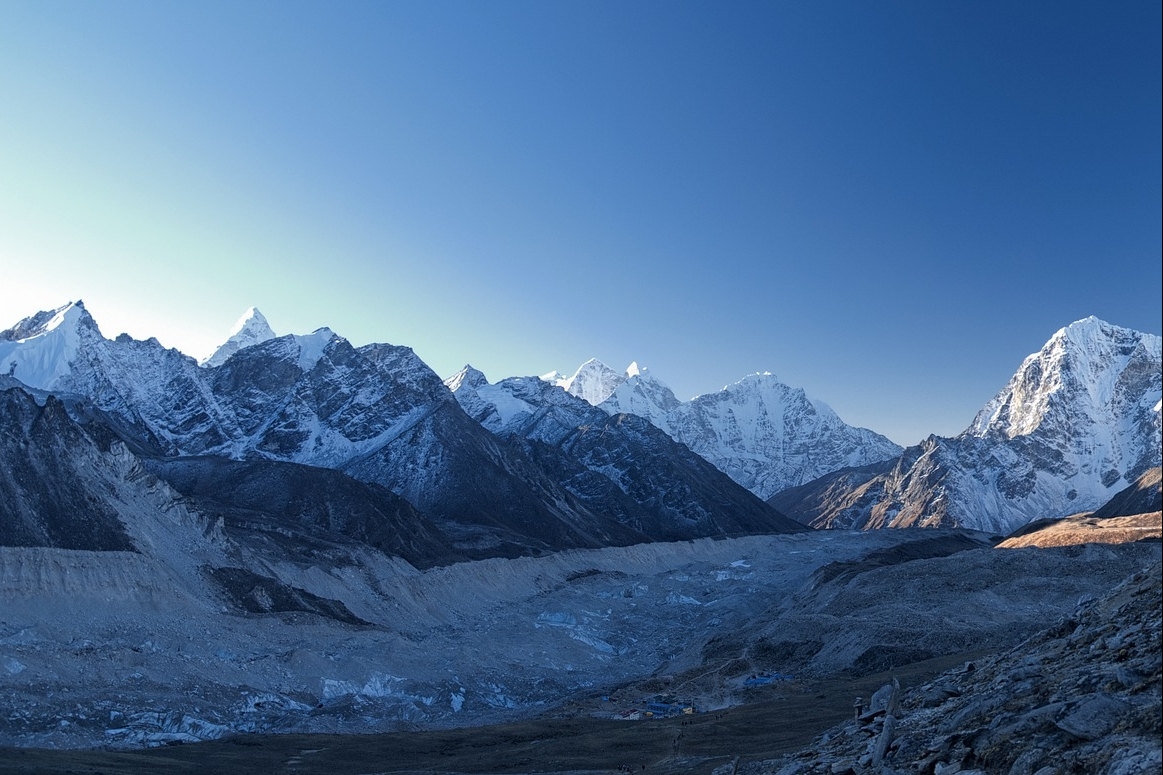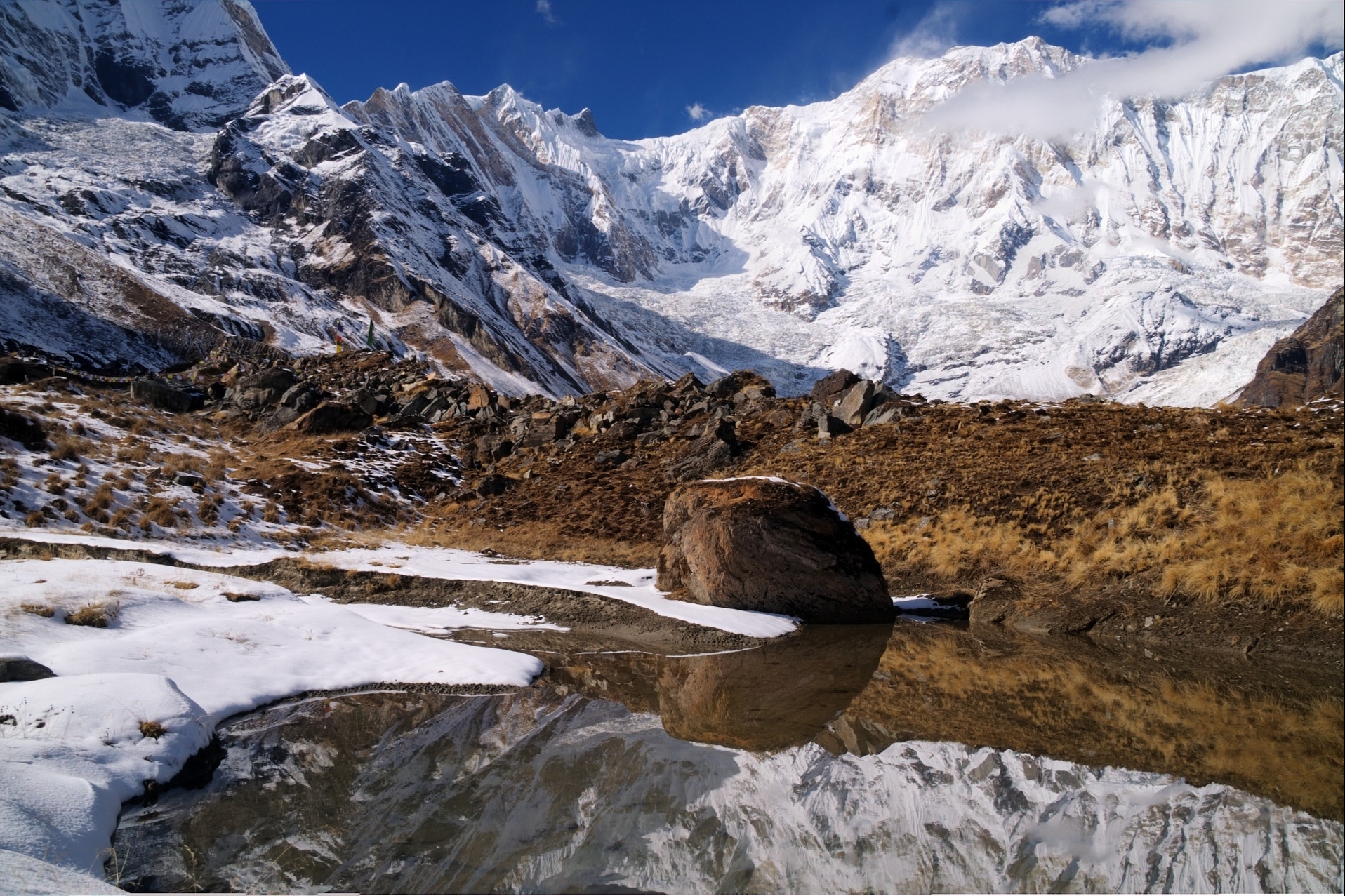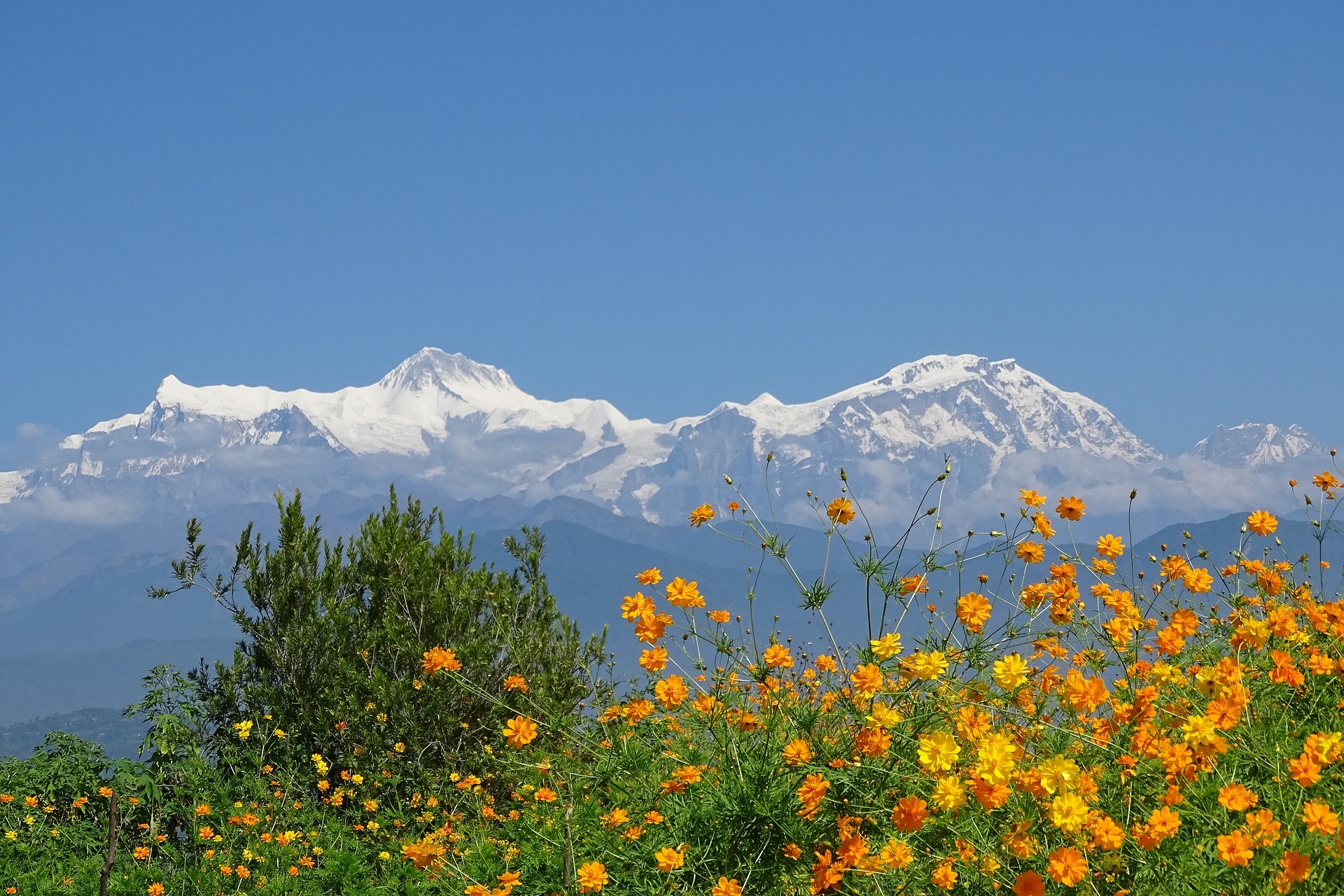One
of the most popular trekking routes in the world, the Manaslu circuit trek offers virtually everything that other
trekking regions in Nepal might not. Attractions like lush green dense
woodlands, a wide range of flora and fauna, rivers with the captivating beauty
of the white noise that soothes the mind, the high mountain passes, thrilling
landscapes, Buddhist monasteries, and traditions of the natives of tropical
regions to the high-Himalayan region.
Arughat,
soti-khola, and Machha-Khola are the starting points for the trip to Manaslu
trek. The time required to enter the trekking zone is almost a day, which starts
with a ride from Machha-Khola to the forests of Jagat via steep ridges,
terraced fields, and suspension bridges. From Jagat, you hike to Deng (1860m),
a quaint village in that area with wonderful views of snow-capped mountains and
beautiful scenery.
Situated in the district of Gorkha MANASLU CIRCUIT TREK offers a stunning off-the-beaten trail route for the trekking trip in the manaslu region. Part of the Mansiri Himalayan sub-range, Manaslu is the eighth in the ranking among the highest peaks of the world.
TIPS FOR SAVING ENERGY WHILE TRAVELING.
It's very essential to be in touch with friends' families and colleagues during the trip to provide frequent updates on travel. To do so, the supply of energy to charge the devices to do the web access is very much required, which is very much necessary to save energy.
Following are some tips to save energy:
Upon our arrival in TIA Kathmandu, we will be greeted by a representative from Plan Nepal Trek who will drop you off at the hotel. After checking in, we will visit our office. In the evening, there will be a welcome dinner hosted by Plan Nepal Trek PNT. For dinner, you will be served excellent Nepalese cuisine, which will introduce you to the country’s authentic food culture. Overnight in Kathmandu



After breakfast, we start a guided tour of several of the most historical and spiritual attractions in Kathmandu. Some of these landmarks, including the historic Durbar Square, the sacred Hindu temple of Pashupatinath, the famous ‘Monkey Temple’ (Swayambhunath), and the Buddhist shrine (Bouddhanath), which is one of the largest stupas in the world, are listed as UNESCO World Heritage Sites. In the evening, we will brief you on your dream trip, trekking.



Drive from Kathmandu to Sotikhola. During the drive, we enjoy views of the Nepalese countryside along with the mountain scenery. We will be driving on a paved road from Kathmandu to Dhading Besi, the district headquarters of Dhading (1050 m), but the drive from Dhanding Bensi to Arughat will continue. Upon reaching Arughat, a major town in the region, we drive further towards Sotikhola. The road is rough. Overnight in Soti Khola.



On the first day of the trek, starting now with the crossing of the bridge, we trek through the beautiful forests, then climb onto a ridge above huge rapids on the Budhi Gandaki. We then reach Khursane, upon which the rocky trail weaves its way up and down, past two tropical waterfalls on a steep, rocky trail clinging to the side of a cliff. It eventually makes its way down and past a few rice terraces, then up and around to the Gurung village of Lapubesi. We further climb behind a rocky outcrop, where the valley opens up and the Budhi Gandaki meanders among wide gravel bars. Dropping to the sandy river bed, we walk along rounded stones before climbing over a side ridge. We head down again to the river and cross another suspension bridge to reach Machha Khola village. Overnight in Machha Khola.



The narrow trail makes some minor ups and downs and eventually crosses the Tharo Khola, reaching Khorlabesi. After a few more ascends and descends, we come across a small hot spring in Tatopani. From the hot spring, we climb over another ridge, then cross the Budhi Gandaki on a suspension bridge. At this juncture, we climb on a wide, well-crafted staircase, then across a landslide and over a ridge to Dobhan. Upon crossing a suspension bridge over the Yaru Khola, we climb the stone stairs, then drop to the river and again climb more stone stairs to Tharo Bharyang. Crossing the west bank of the Budhi Gandaki, we'll go across a ridge, trek along the river, and then climb towards the village of Jagat where we'll be staying Overnight.



We'll begin today’s trek by climbing over a rocky ridge to Salleri and then descending to Sirdibas. The valley widens a bit as the trail continues up to Ghatta Khola. We continue walking upstream to a long suspension bridge in Philim, a large Gurung village. The trail turns north just above the lowest house in the village and stays on a fairly level trail as it crosses millet fields to reach Ekle Bhatti. The route now enters a steep, uninhabited gorge. At this point, we descend to the grassy land slopes, cross the Budhi-Gandaki, then trek along the west bank for a while, then cross to the east bank and then back again. As we continue through the trail, the valley widens, and we pass through bamboo forests to the Deng Khola. Upon crossing the Khola, we reach the tiny village of Deng. Overnight in Deng.



After a brief walk beyond Deng, we cross the Budhi Gandaki and climb to Rana at 1910m. From the bridge, we climb a bit to join a trail from Bhi, then head west up the Budhi Gandaki valley. The trail also passes through forests and mani, where we turn towards a corner that contours to Ghap. Even though there is another route, we take the route through Prok village. Prok village has a viewpoint for a beautiful sight of the Siringi Himal. We further crossed the Budi Gandaki several times today and came across several gompas en route. The trail follows the river upstream through a dense forest. After crossing the river at an impressive spot where it thunders down a narrow gorge, the forest becomes less dense, and the trail is fine again. The pleasant walk continues, and after a last steep climb, we reach Namrung. Overnight in Namrung.



Namrung village is a good viewpoint for Siring and Ganesh Himal, and from the village, one can also see Mt. Himal Chuli in the south. We climb steadily, pass through forests, and reach Lihi, a fine village with many chortens and barley terraces. The trail drops and crosses the side valley of Simnang Himal, with Ganesh Himal always close by. We further pass through the Sho, Lho, and Shyala villages before reaching Sama Village. We enjoy extraordinary views of Mt. Manaslu from Lho village and also explore the famous Ribung Gompa. In Shyala village, we will be surrounded by high mountains like Himal Chuli and Peak 29 (Ngadi Chuli) to the left, Manaslu and large glaciers straight ahead, and other snow summits to the right. At the far end stands Ganesh Himal. Today’s journey ends in Samagaon, where we spend the night.



We spent the day at Samagaon both for rest and acclimatization. Today, we get acquainted with the rich Sherpa culture. We enjoy the sight of thousands of Mani-stones with Buddhist texts and pictures and the Sherpa women clad in traditional clothes and ornaments. On a little hill near the Sama village is an old gompa (Pungyen gompa), a monastery with great views of the glacier. It is named after Manaslu, Pungyen means bracelet, which is a good description of the two peaks. It was destroyed a year after the first unsuccessful Japanese attempt to climb Manaslu. The locals believed that the climb angered the gods, and when the Japanese came back a year later, they met with so much resistance that they had to give up their attempt. They were finally successful in 1959. Samagaon will be our endpoint of the trip for the day where we'll stay overnight.



Now, we descend to the Budhi Gandaki River, which has turned north, and follow it to a bridge over a side stream. The trail to the left leads to the Manaslu Base Camp. The Larkya la Trail passes several mani walls as the valley begins to widen. It is an easy trail on a shelf above the river, passing the juniper and birch forests of Kermo Kharka. We drop off the shelf, cross the Budhi Gandaki on a wooden bridge, and climb steeply onto a promontory between two forks of the river. From a stone arch, we can view a large white kani. Finally, passing through the kani, we'll reach Samdo where we'll be staying overnight in Samdo.



This is another day set aside for proper acclimatization. There are two options for us today. The option that we highly recommend is a hike up the valley, directly at the back of the Samdo village. This hike will take us to one of the trade passes to Tibet for excellent views of Mt. Manaslu along with other Himalayan ranges including Simrang, Hiunchuli, Ngadi, Larkye Peak, Cheo, and possibly Kang Guru behind the pass. En route to these viewpoints, we pass many seasonal herding settlements called doksas and sight some beautiful mountain birds like the Lophophorus (the national bird of Nepal), Lammergeyer, and Himalayan Griffin soaring high above us. Another option for today could be a trip to the Gya La (‘large pass’) to the north of Samdo, a more frequently used trading route to Tibet. But this is a rather longer hike (the whole day) and hence could be a little tiring. Overnight in Samdo.



We continue our walk down the edge, cross the wooden bridge over Budi Gandaki, and begin walking upward. Upon crossing two streams and witnessing the Larkya Glacier, we go around the valley of the Salka Khola and climb up again to the stone guest house (4450 m), which is not a lodge but a kind of shelter called Dharmshala, also known as Larke Phedi. The short walk today also leaves plenty of time for acclimatization and relaxing in the afternoon. overnight stay will be at Dharmashala.



After a short climb, we reach a valley on the north side of the Larkya Glaciers, from where we can enjoy great views of Cho Danda and Larkya Peak. Finally, we walk across the moraines of the glacier, making a gradual ascent that becomes steeper only in the last section of the pass. In the pass, there are outstanding views of Himlung Himal, Cheo Himal, Kangguru, and the huge Annapurna II. It is a longer day than usual to Bimtang, but to walk into these low pastures with the evening mist coming in with Mt. Manaslu looming close by is an overwhelming experience. Overnight in Bimthang.



From a ridge at Bimthang, we can enjoy great views of Mt. Manaslu, Lamjung Himal, Himlung Himal, and Cheo Himal. We descend further and cross a high pasture (Sangure Kharka) followed by a bridge over Dudh Khola. We walk through a rhododendron forest and follow a trail through a narrow valley until we reach the highest cultivated land of the valley at Karche, 2785 meters. We pass across fields before making a steep climb over a ridge. The trail comes off the ridge in a big, sweeping arc to the river bank at 2580m. A short distance beyond is the village of Gho. Due to yesterday’s tiredness, we might take an overnight rest at Gho but better lodges are available at Tilije, so Himalayan Glacier recommends we stay at Tilije. Overnight in Tilije Village.



We climb over a small ridge and enjoy the stone-paved trail as it passes through a beautiful village. We then cross the bridge over Dudh Khola and climb up through a chorten-shaped arch, pass a mani wall, and reach the Thonje village. At the village, we go through a police checkpoint and continue to Dharapani. We have entered the Annapurna circuit section from Dharapani. Further down, we come across Karte village and after quite a bit of walking, we cross a bridge over Marshyangdi Khola. We also come across some mani walls before reaching the village of Tal, situated at the foot of a large waterfall.



The drive from Tal to Kathmandu via Besisahar offers one an opportunity to enjoy both hill and mountain landscapes. The drive is often along the banks of the Marsyangdi and Trishuli rivers. We also drive by some beautiful villages with farming terraces on both sides of the road. In Kathmandu, we will be escorted to our hotel. The day in Kathmandu can either be spent in leisure or perhaps we catch up with some last-minute shopping. To celebrate the successful completion of our journey, we will have a farewell dinner in the evening. We will exchange our experiences and pictures with each other.



Today is your last day in Nepal. After a good breakfast in the morning, as per your choice, You'll be heading towards the airport for the flight, and on the way, you'll be accompanied by one of our delegates, who'll also be taking your feedback regarding the trip. The trip to the airport will be 3 hours before the flight, as per the regulations.


When I landed and walked ahead, I was greeted beautifully and with the best hospitality from the staff. It was one of the best and most memorable experiences of all of my trips. Thanks to Mr. Dinanath Panta and the team for the coordination and for making my trip one of the best and most memorable moments of my life.

TREKKING EQUIPMENT
TOILETRIES
FIRST-AID KIT AND MEDICATIONS
ESSENTIAL BACKPACK FOR TRIP
CLOTHING
It depends on the walking pace of the traveler, but it's advised for travelers on this route to walk at least 3 hours per day on average.
It is advised for travellers to use drinking water only after purifying or boiling, but mineral water is also available there, which you can buy if you want to.
Teahouses have a basic range of amenities available, with a limited variety of food items on their menu. The rooms are spacious, with two beds and blankets. they have western toilets and hot water shower facility.
The perfect seasons to visit this region are autumn and spring due to the pleasant weather with beautiful mountain views and clear blue skies, and in the spring season, the densely vibrant rhododendron will truly cheer up the day of any visitor.
Try not to disturb the natural state of the wild-life habitat as much as possible, and do not play any sort of music or do any activities that might disturb the plants and wildlife.




